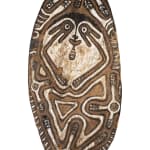Anonymous artist
Gope Board
Wood
Origin: Papua New Guinea
Old inventory number “0286” on the back
Origin: Papua New Guinea
Old inventory number “0286” on the back
height 139 cm
height 54 3/4 in
height 54 3/4 in
Copyright Duende Art Projects
Photo: Valentin Clavairolles
Further images
Gope boards are among the most iconic types of New Guinea art. The gope of the Van Strien collection stands out as one of the masterpieces of the genre. An...
Gope boards are among the most iconic types of New Guinea art. The gope of the Van Strien collection stands out as one of the masterpieces of the genre. An archaic example, it displays great age and presents a beautiful graphic design and powerful expression. Characterized by an elongated elliptical shape, with its deep carvings in high relief this wooden board verges on two-dimensionality. The designs were painted with lime (to whiten), red ochre, and other indigenous paints. Centrally we find the typical spirit face, gazing at us with is two white eyes with black circular pupils. Typically, the eyes are framed by a red-painted motif, which recalls a bird’s head. As the face is carved in relief against a large sunken background of white, the design visually pops out. A thin nose with prominent round nostrils and smiling open mouth gave the face a most attractive appeal. The oval motif underneath the mouth probably refers to a shell necklace worn as a prestige item. It is especially the lower design which sets this gope apart within the corpus. The asymmetric treatment of the triangular-shaped navel presents an innovative design – a feature of an early example of the type. The navel symbolized the place or origin for the clan. The Swiss anthropologist Paul Wirz in the early 1930s noted that the most important gope such as the present had their own personal names and were under the care and protection of the entire clan. Such boards were the abode of supernatural spirits and kept in clan’s ceremonial house, where they were taken care off and occasionally repainted. In the nineteenth to early twentieth century, men lived apart from women and uninitiated boys. Their large houses had designated areas or shrines created for the display of items that indicated personal status and clan identity. Multiple spirits boards were placed in these shrines and served as reminders to their owners about their responsibility to the clan and the community. In the men’s house, gope were the frequent recipient of offerings in exchange for benign assistance of the spirit they housed. Clan members pleased them through various means to harness their powers for individual or communal benefit. Their protective abilities were summoned during times of warfare, while hunters would plea for a fruitful hunt. It was said that the spirit of the board would go into battle with the men who worshipped it. The spirits protected clans from sickness, malevolent spirits, and death. With its great, aged patina from generations of use, this monumental spiritually charged board an important testament of this region’s art. The high-relief carving, juxtaposing light and dark colors, combined with a beautiful graphic design, accounts for the exceptional quality of the Van Strien gope.
Provenance
Jean Claude Bellier, Paris, 1974
Lucien Van de Velde, Antwerp, 1976
Cees Van Strien CollectionBy descent through family, 2022







